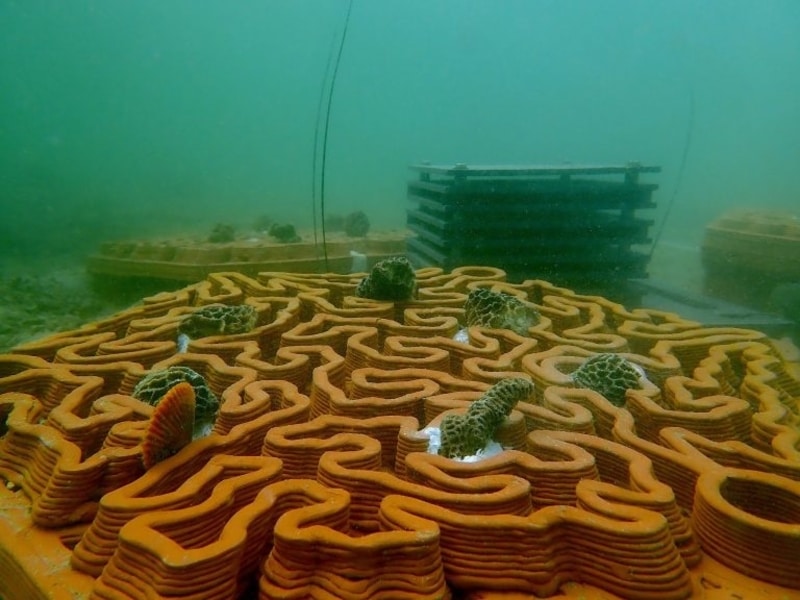A team of marine scientists and architects in Hong Kong has created the first 3D-printed terracotta ‘reef tiles’ to help restore eroding local corals. In July, the first clay coral tiles were placed on the seafloor at Hoi Ha Wan Marine Park in Sai Kung as part of a week-long endeavour. Could this be the future of coral restoration and conservation?
—
Marine scientists from the Swire Institute of Marine Science (SWIMS) have been collaborating with architects from Hong Kong University (HKU) to construct the world’s first terracotta coral tiles in the hopes of conserving marine habitats.
Built at HKU’s Faculty of Architecture, the Reformative Coral Habitats Project has been printing clay hexagonal tiles mimicking the natural shape of brain coral since 2016. The 3D-printed tiles placed on the Hong Kong corals limits negative impacts on the ocean’s biodiversity and prevents potential interference with natural coral’s growth patterns. Vriko Yu, a student involved in the project, said the coral tiles act as a ‘substrate that can facilitate coral restoration, while conserving the local biodiversity’.
The project will see the installation of 128 reef tiles, covering approximately 40 square meters of seafloor in total, at three sites within the marine park. One of the three sites was so badly damaged that its coral communities had deteriorated into sand.
“Our hope is that our planted corals can become big enough to stabilise themselves and form a natural habitat,” Yu says.
You might also like: Heat-Resistant Corals Found in the Red Sea Bring Hope Amid Climate Crisis

Photo: Hong Kong Agriculture, Fisheries and Conservation Department (AFCD).
Weighing around 20 kilograms and measuring 65 centimeters in diameter, each tile consists of three parts: the legs, nine-grid layers and six coral-like layers. Together, the tile units act as an anchoring bed for corals to attach to and grow. Lidia Ratoi, assistant lecturer at HKU, says, “the tiles aren’t conventional tiles. Hong Kong’s subtropical climate entails much underwater sedimentation. That’s why our tiles have a lot of perforations so that sediment doesn’t deposit on the surface and suffocate the corals.”
The team hopes that once the environmentally-friendly terracotta tiles have helped to regenerate coral communities, they will erode and disappear into the seafloor. The 3D printed corals have also been carefully designed to withstand the unique water conditions in Hong Kong- marked by water pollution, overfishing, bioerosion and excessive sedimentation- which precipitated the collapse of local marine ecosystems, including corals.
Hong Kong waters are one of the harshest environments for coral to thrive in; those that are able to grow and flourish in such environments are referred to as ‘super-coral’. “Hong Kong is not an easy place for corals … The water quality has improved a lot over the last decade which has given us one important condition to keep the corals healthy. However, there are some external factors like red tides and typhoons which could take away our efforts in a blink of an eye,” Yu told Hong Kong Free Press.
In addition to restoring marine life and providing habitats for small fish, coral reefs protect coastlines from storms and erosion, provide jobs for local communities, offer opportunities for recreation and are a source of food and new medicines.
Going Forward
As the project develops, the team will monitor the sites quarterly, collecting data on the amount of corals that attach to the tiles and the biodiversity levels within the developing reefs. Though still in its early stages, the project’s success thus far is a positive advancement towards marine preservation and conservation in Hong Kong. Yu hopes that the project will encourage and inspire other cities to preserve and restore their local reefs: “If we can do it in Hong Kong, we believe other metropolises can do it, too.”
The marine team estimates that the effort will generate a total area of restored coral habitat of about 40 square metres. “This is quite small compared to the total area of coral communities in Hong Kong,” said David Baker, director of SWIMS and associate professor. “However, even small patches of corals can enhance local biodiversity by creating a home for other species, and small patches can be very important in the long-term by generating propagules – baby corals that can settle on nearby areas, thus spreading corals naturally in our area.”
Featured image by: Vriko Yu
You might also like: Explainer: What Is Coral Bleaching?

















